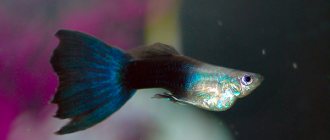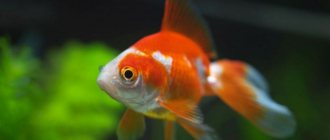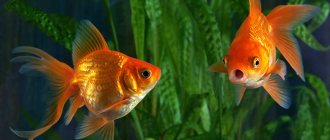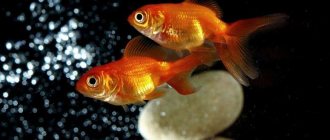Goldfish nutrition
For normal functioning, pets need a balanced diet rich in proteins, vitamins, minerals, carbohydrates and fiber.
For the high-quality formation of immunity, it is recommended to alternate food of animal and plant origin.
Vitamin A must be present in the diet, as it affects the color saturation of goldfish. If the color of the body has become cloudy or faded, there is a deficiency of vitamins; they urgently need to be replenished. Gold Color premium food has proven itself well . It is this that helps maintain the brightness of the color.
What do goldfish eat?
Goldfish found in the aquarium are selected varieties and cannot be found in the natural environment. Unlike their wild relatives, the inhabitants of the aquarium are more whimsical and demanding of their living conditions. Particular attention should be paid to feeding goldfish .
The inhabitants of the underwater world love live food: daphnia, bloodworms, tubifex, earthworms. However, the breeder should be aware that when feeding fish with live food, a lot of time will have to be devoted to maintaining the life of plankton and insects. And before feeding earthworms to fish, they must be kept in clean water for several days to cleanse their intestines.
Earthworm
Tubifex
Bloodworm
Sometimes you can give shrimp, shavings of lean beef, and squid. Millet, wheat, buckwheat and semolina, steamed in unsalted water, ideally diversify the diet of goldfish. However, all these delights will not replace plant food, which makes up most of the diet of adults.
Care and maintenance
Aquarium goldfish are quite undemanding when it comes to water parameters. The temperature range for comfortable existence is quite large: from 18 to 30 degrees. Changes within this interval will not cause any particular problems. However, many breeders note that in the winter-spring period it is better to maintain the temperature within 18-200C, and in the summer-autumn period 20-240C to create the most comfortable conditions.
An aquarium for goldfish must be selected at the rate of 50 liters per individual. The larger the total volume, the less free space one fish needs. But this does not mean that you can fill a huge aquarium with fish to capacity. In a volume of 150 liters you can already add not 3, but 4 fish, and already in two hundred liters 5-6 individuals will feel free.
- Goldfish love to dig in the soil, so there are a few challenges that come with this. There will always be suspended particles present in the aquarium. Not all plants can tolerate this, because the leaves will be constantly contaminated. It is worth choosing plants with hard leaves that are unpretentious to water quality. The soil must be chosen as hard, preferably from fairly large fractions of gravel.
- Some of the water in the aquarium should be changed every week, and the aquarium should be washed every 2-3 months.
- For a long time, fish were bred in open ponds on the estates of nobles, so the whole breed was accustomed to a sufficient amount of oxygen. It is worth taking care of good aeration of aquariums.
- Goldfish need salt. They can easily tolerate unsalted water, but if their health worsens, it is better to add salt to the aquarium at the rate of 2 teaspoons per 1 liter of water.
What to feed goldfish
The menu should include both plant and animal food, and dry food. It is important to alternate them so that your pets receive all the necessary vitamins and microelements.
Protein feed
You can prepare protein food yourself. This is a good alternative to live and dry food, and the nutritional value of protein nutrition is on par with industrial supplements.
Frozen fish. Before freezing, fish fillets must be minced, divided into portions, placed in containers or bags, and frozen. Such food can be stored in the freezer for a long time without compromising quality. Before feeding, remove the mass from the freezer and defrost. Portions should be small.
Egg. A raw egg is poured into a glass, the yolk and white are mixed, and beaten. The contents of the glass are poured into boiling water in a thin stream.
Boiled fish. Cod works well. After boiling, finely chop with a knife or pass through a meat grinder. Portions are small.
Milk. More precisely, a film of boiled milk. Remove the film and shred it.
Attention! When feeding your pets with protein foods, remember that they are highly perishable! Therefore, immediately after finishing the meal, the remains must be caught with a net from the aquarium, otherwise the food will rot and the fish will get sick.
Milk film
Frozen minced fish
beaten egg
Boiled fish
Balloons
The balls contain a large amount of protein. Before feeding, the balls are soaked in water until softened. If pelleted food causes your fish to have difficulty swimming, you may need to stop feeding them pelleted food.
Fry
At a temperature of 20-21°C, the incubation period lasts 3-5 days. A fry that has just hatched from eggs is very weak and helpless. It looks like a string, equipped with two eyes at one end and a gall bladder in the middle. The gall bladder contains a supply of nutrition for the fry in the first days of its life. At first, the fry can move in small jerks and has the ability to attach itself to the place it touches. After another 3 days, the fry begin to swim more freely and already need food.
Ideally, the water should be blown through an airlift filter, but at such a speed that mixing the water does not disturb the larva, but knocks off the bacterial film from the surface of the water.
It is not recommended to leave fry with large deviations from the norm. The fry must meet the following requirements: have the same size and direction of eyes, fins and growths; have an egg-shaped body (if this is typical for the breed), without deformations or flaws; tail without torn places or bends. The juveniles develop quickly, but unevenly. Periodically, the fish must be sorted by size, starting from the fourth week.
The fry should be kept in the same aquarium where they were hatched for up to two weeks. After this, they need to be seated, placing no more than 250 fry in a 30-40 liter aquarium. They can be kept in such an aquarium until they are two months old, sorted by size. As the young grow, their number in the aquarium should also decrease. At an early age, it is not recommended to catch fry with a net; it is better to transfer them to a saucer, in which the fry are clearly visible and can be counted.
In order for the fry to have bright colors, daylight is necessary. If the aquarium is illuminated by the sun for more than two hours a day, then the fry must be protected from direct sunlight by creating shaded areas in the aquarium with plants or shields. If there is no daylight, a bright electric light is needed.
Breeding live food at home
The method of breeding living organisms for feeding goldfish is quite labor-intensive, but justified. Live food bred at home is a safe food for underwater inhabitants. You can be sure that no infection will enter the species aquarium along with the food.
Rules for growing live food:
- In a tank with living organisms, it is recommended to constantly change the water.
- You cannot use only one container for growing, otherwise if some part dies, it will be impossible to save the rest of the food.
Too nutritious substrate leads to rapid reproduction of living organisms. A large livestock pollutes the water with waste from its vital activity, as a result of which the oxygen level decreases and the subculture dies.
Daphnia
Live food is suitable for feeding fry and is ideal for most fish. Under natural conditions, it can be found in bodies of water with warm, standing water.
The choice of crustaceans for breeding should take place in reservoirs in which there is no fish - the risk of infection is minimized.
Daphnia
Growing crustaceans at home is possible in a tank with well-settled water and an aerator, since daphnia are too sensitive to the presence of oxygen. The optimal temperature is +22-24°C.
You can feed with beet, carrot, and cabbage juice. Daphnia food is not only excellent food for fry, but also perfectly purifies water from contaminants.
Nematode worms
For breeding at home, worms are looked for in last year's wet leaves and placed in a container with flour and milk. After a few days, the worms will multiply, they are scraped off with a stick and used for their intended purpose. Nematodes in an aquarium are excellent food for goldfish.
Drosophila flies
If you don’t notice how the side of the apple has rotted, the fruit flies are already right there. To reproduce, insects should be placed in a special container with any fruit puree mixed with yeast and oatmeal.
Enchytraeus soil worm
Fish love little white worms. For propagation you will need a box with damp garden soil, covered with plywood. For feeding, boiled potatoes mixed with milk and black bread crumbs are used. You can find material for propagation by digging up potatoes. These worms attack the mother tuber.
Nematode worms
Drosophila flies
Enchytraeus soil worm
During vacation
If you leave the aquarium unattended for a couple of weeks, then use special food and automatic feeders with a dispenser. Briquette and capsule feeds dissolve slowly in water, providing nutrition for a long time. If feeding fish during absence is entrusted to friends, tell them about how to care for aquarium inhabitants. You can package the food into equal parts to eliminate the risk of overfeeding and give the necessary advice.
With proper feeding, fish are protected from diseases. Healthy fish live longer, have bright colors and are agile.
Food for different types of goldfish
Depending on the type of fish, appropriate nutrition is selected.
Butterfly - goldfish
They feed on plant, live and dry food. Bloodworms, daphnia, tubifex, and earthworms can be used as live food.
Butterfly - goldfish
Dry food is given in limited quantities, otherwise feed crumbs consumed in large quantities will lead to disruption of the digestive tract.
Plant foods include plants and boiled cereals.
In the diet of butterflies, carbohydrates should prevail over protein. This feature will help maintain the brightness of the body color.
To prevent butterflies from eating live plants in the aquarium, it is recommended to feed them with a duckweed plant supplement.
Jikin - goldfish
The fish are kept in a goldfish aquarium, with a well-equipped filtration and aeration system. The diet is practically no different from other types of goldfish. The diet should include all types of feed. Particular attention should be paid to feed of plant origin.
Nanjing - goldfish
Taking into account the peculiarity of the fish - its low speed of movement, it is necessary to arrange feeding in such a way that its nimble neighbors do not eat all the food and leave them hungry. Nanking is a picky fish; it feeds on dry, animal and plant foods.
Tosakin - goldfish
The pet's menu should be dominated by live food. Tosakins love small earthworms. Koretra is an ideal dietary food. You can give bloodworms and tubifex. They love tosaquins and boiled fish.
Jikin - goldfish
Nanjing - goldfish
Tosakin - goldfish
How many times
Adult healthy fish in an aquarium should be fed 1-2 times a day. Morning feeding is carried out 15 minutes after turning on the light, evening feeding - 3 hours before bedtime.
Growing fish are fed frequently: up to the age of one month, 6 times a day, and after that they are transferred to four meals a day. After a month, the frequency decreases. Catfish and other bottom-dwelling fish are fed in the dark when the aquarium population is sleeping.
In an artificially created habitat, fish are less mobile, since they are not forced to get food to survive. Therefore, it is correct to feed aquarium fish six times a week.
Hunger strike
A mini-fasting once a week allows you to:
- prevent obesity;
- cleanse the body;
- increase sexual activity;
- activate recovery processes.
What to feed aquarium fish in the summer without buying food
The ideal option is porridge without added salt and sugar. You can give white bread, crumbled into small pieces.
Plant food alone will not be enough, so you can catch cyclops and daphnia with a net. They can be found in coastal areas. For fishing, a net covered with knitted fabric is used. Caught daphnia and cyclops are kept in a basin of water.
Dried daphnia are an excellent food for fish in winter. Dry on a stretched cloth in the sun. Before feeding, fish oil is added to the dried food.
How to make fish food with your own hands
Many aquarists do not approve of this type of food, such as food prepared at home. However, there are also adherents of this method. Homemade food can be prepared from seafood, beef heart, vegetables, grinding them in a meat grinder. The resulting minced meat is divided into portions and placed in the freezer for storage.
Goldfish food recipe based on beef heart
Beef heart is subject to heat treatment - it should be cooked for 2 hours. You cannot add salt or spices. Each time foam appears, it will have to be removed. After the heart has cooled, it needs to be grated, divided into small portions and frozen.
Beef heart
The best
It is preferable to feed frozen food. The possibility of infecting the aquarium is minimized. Freezing is easy to dose, does not spoil, and retains its taste and beneficial properties. Mixtures of several types of worms are available for sale, making the food more nutritious.
Important feeding rules
Experienced aquarists advise buying food at pet stores and not overdoing it with homemade food.
- Goldfish are very voracious creatures; they will eat as much as there is food. After feeding the fish, it is important to remove any remaining food so that the water in the tank does not become cloudy overnight and lead to various diseases.
- A time interval for feeding should be set, preferably at the same time. This way the fish will get used to the regime, and you won’t have to worry about them not eating enough or overeating.
- Telescope is a slow fish, it eats for at least 15 minutes. Then you should remove all leftover food. Other types are saturated in 10 minutes.
- Overeating leads to diseases and impairs physical activity. To avoid problems, it is recommended to give underwater inhabitants a fasting day.
- Pets need carbohydrates more than proteins. It is important for goldfish to maintain the beauty of their color, and this can only be achieved by a high carbohydrate content in their food. It is better to buy ready-made food. A balanced diet will improve your well-being and enhance the decorativeness of your body color.
- Usually fish do not touch plants. If this fact occurs, it means the fish are starving. Underwater inhabitants do not touch egg capsules, vallisneria, and arrowheads, since these algae have hard foliage. To prevent goldfish from extracting plant roots during soil excavation, it is recommended to plant greenery in pots.
Regular water changes and general cleaning of the aquarium will help keep your pets healthy.
Reproduction
An ordinary goldfish is ready to reproduce already at one year of age, but individuals reach full maturity by 3-4 years. This period is ideal for selection. Spawning begins in the spring, by which time the appearance of the fish changes noticeably. The gill covers and pectoral fins are modified, and in females the abdomen increases.
The female and two or three males are transferred to a separate aquarium during breeding. Spawning lasts approximately 5-6 hours, after which the fish are returned back. During the season, the female is capable of laying about 10,000 eggs.
Determination of gender
Owners who want to breed them are usually interested in determining the sex of their pets. There are several ways to do this.
The easiest one is to identify males during spawning, since growths appear along their pectoral fins and gill covers, and teeth form on the front fins. Females at this time swell in the abdominal area.
The second way is to compare the area between the anal and pelvic fins: in females it is soft, and in males it is hard. The third method allows you to determine sex by color - in females it is brighter.
What is the difference between feeding selective goldfish?
Feeding of selected species has significant differences. Lionheads, telescopes, veiltails, and orandas deserve special attention.
Taking into account the characteristics of each variety, manufacturers have developed special feeds. The line of highly balanced food includes not only plant ingredients, but also sprouted wheat. It is wheat that prevents metabolic disorders, to which scrofula is so prone.
In addition, there are special foods for sale for Japanese goldfish. The peculiarity of this species is that representatives of the species collect food from the bottom. If you feed them non-sinking flakes, the fish will take in air and float upside down on the surface. Such feeding will not lead to anything good. Of course, after a while the air comes out and the fish swims again, as before. Therefore, Japanese varieties must be fed sinking pellets to avoid rolling over.
Feeding goldfish should be carried out in accordance with the variety, since some need mainly animal food, others need plant food. Only a balanced diet will help strengthen the immune system and increase the body's resistance to various infections.
Did you manage to learn something new? Share in the comments!
Compatibility
Finding suitable neighbors for goldfish is a difficult task, as these charming creatures show compatibility only with their relatives. At the same time, it is not recommended to keep individuals with different body lengths together, since they differ not only in size, but also in temperament.
Having settled goldfish with other representatives of the underwater kingdom, you should be prepared for inevitable injuries to the eyes, fins and scales of golden beauties. Large and aggressive species will attack goldfish, while small and peaceful fish will become dinner for goldfish. In any case, proximity to other species will negatively affect the life expectancy of goldfish.
(1 rating, average 4 out of 5)











